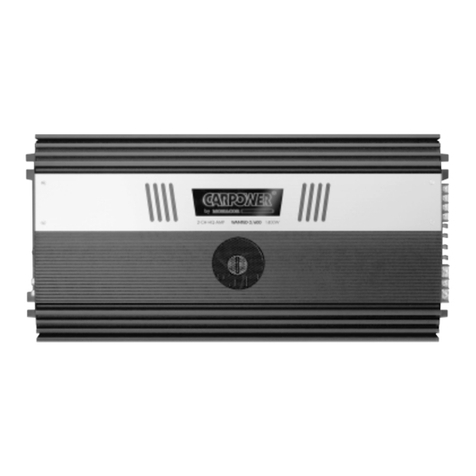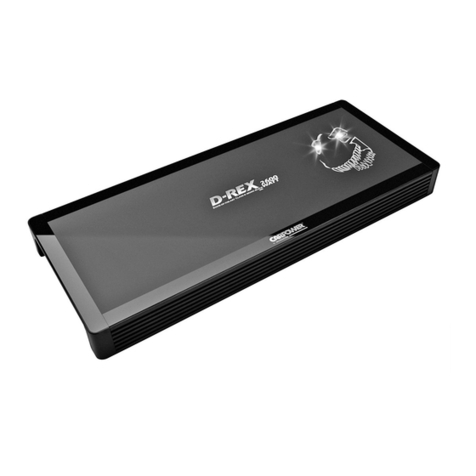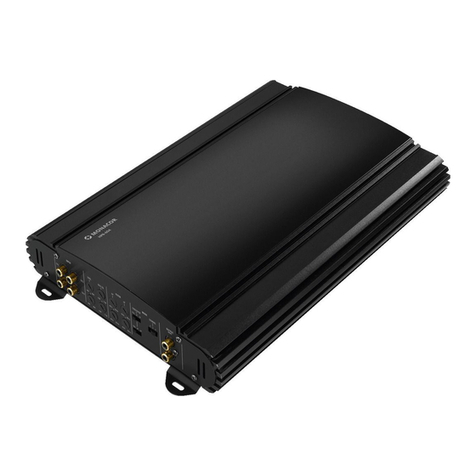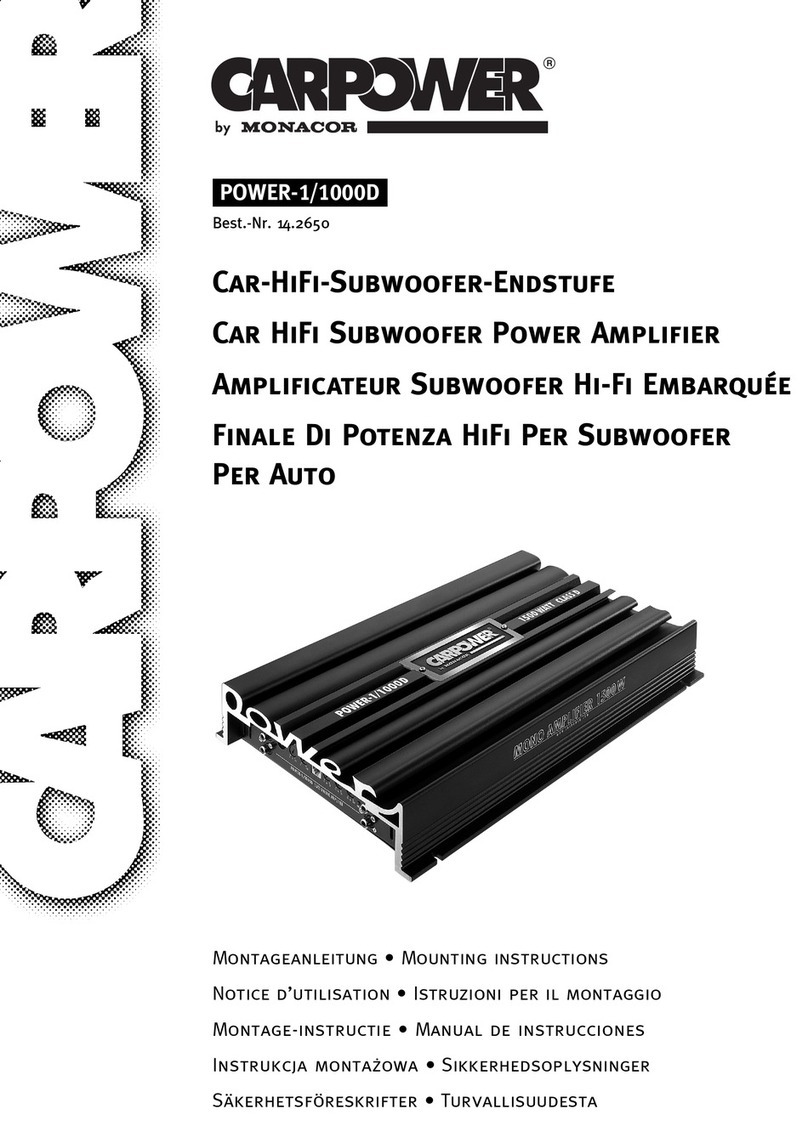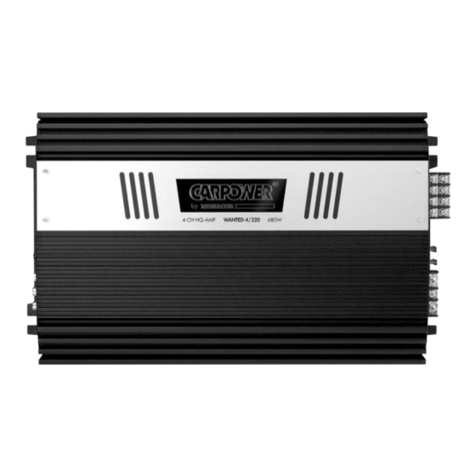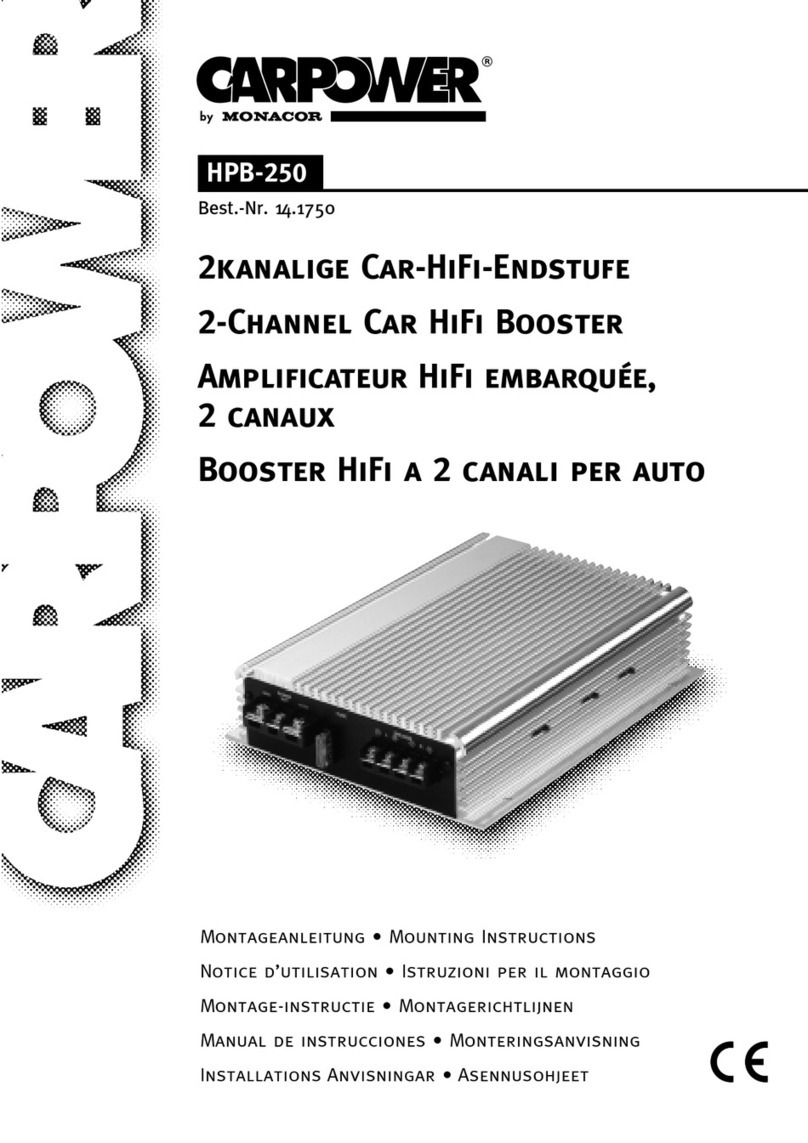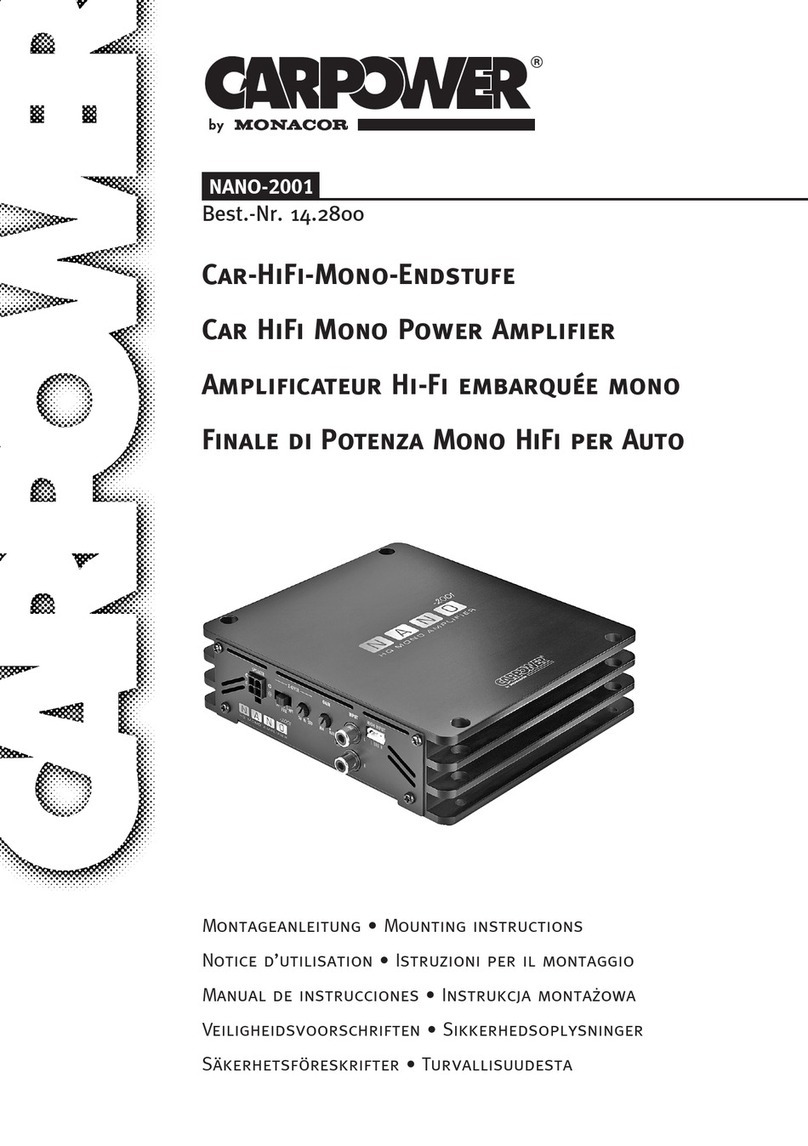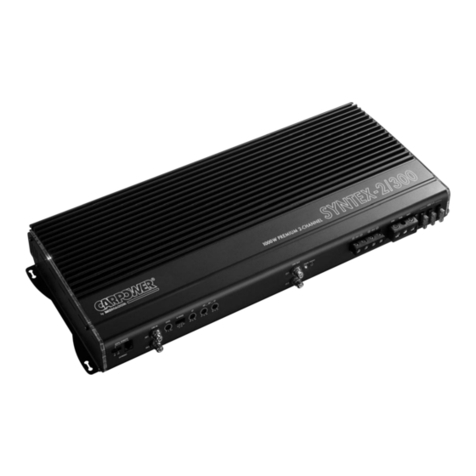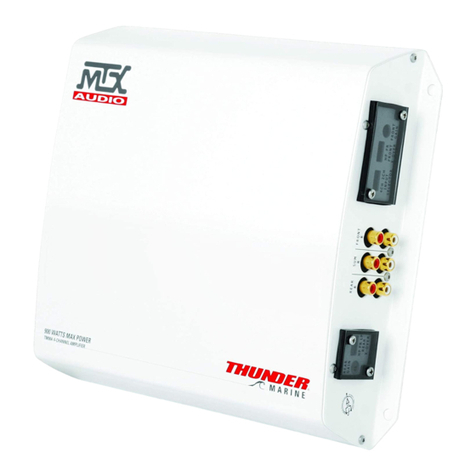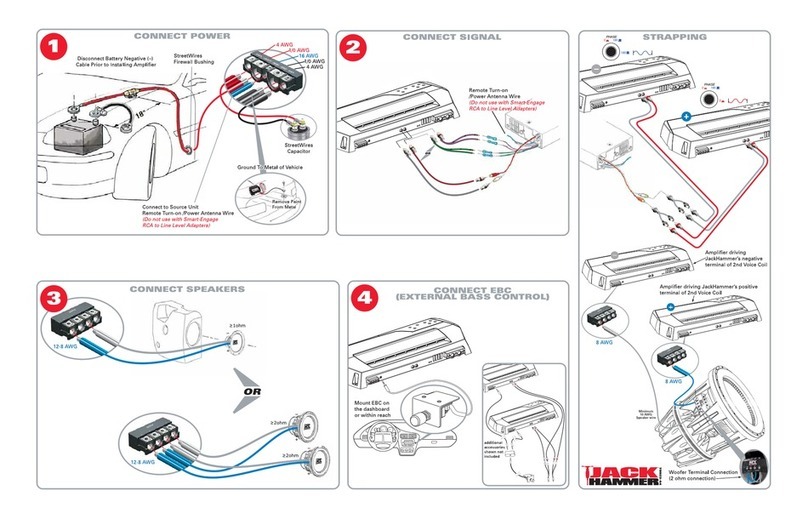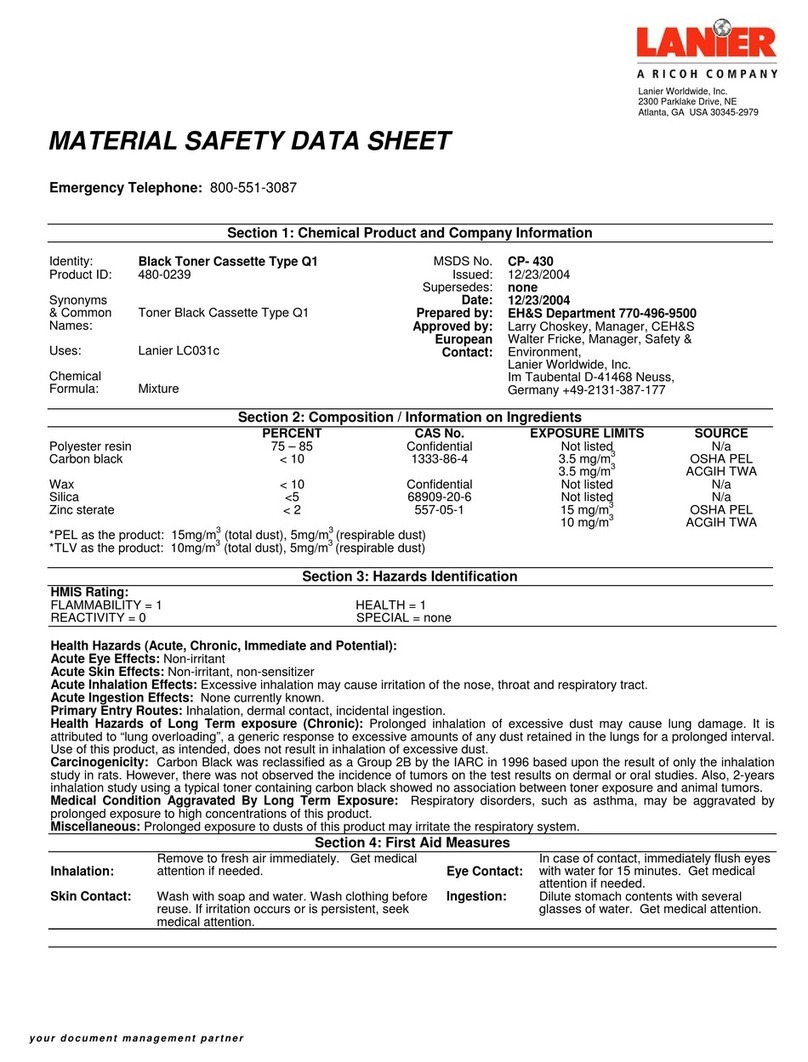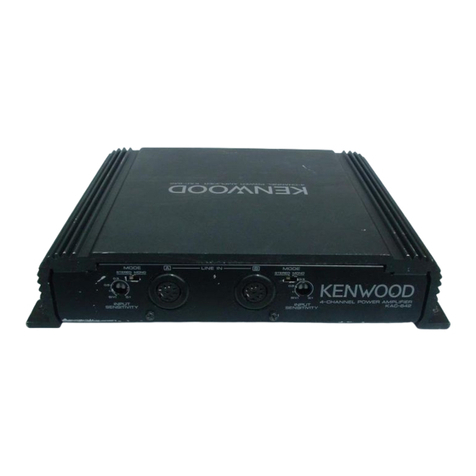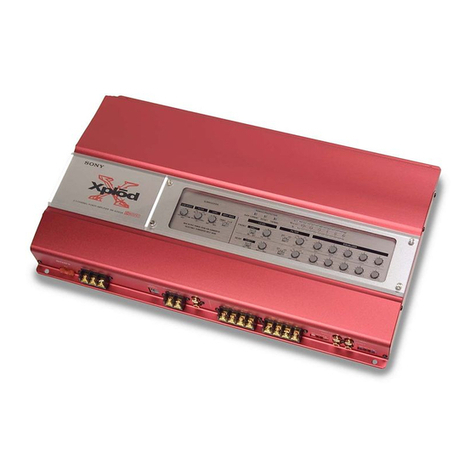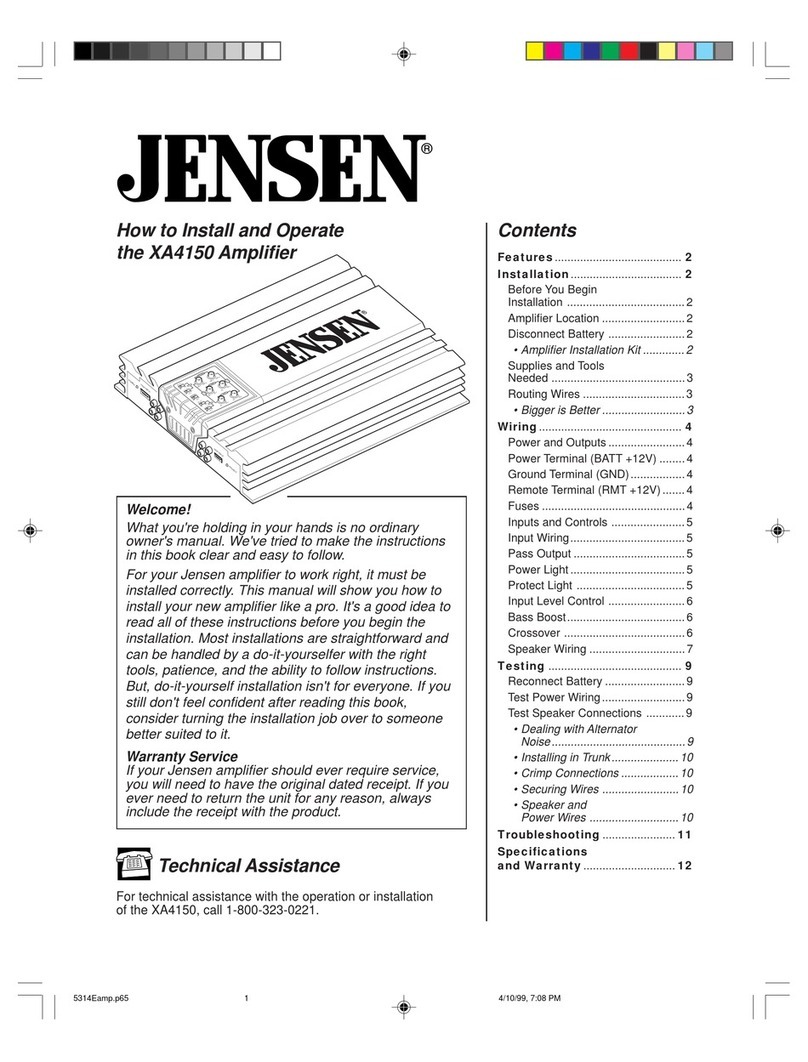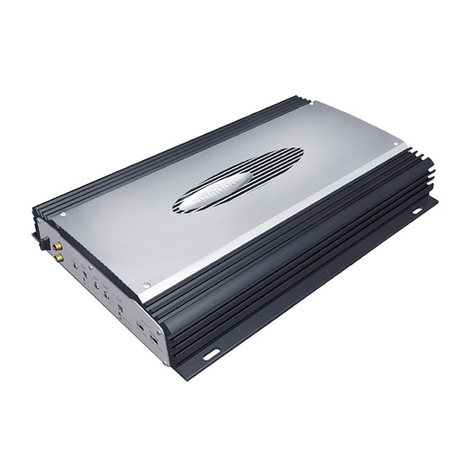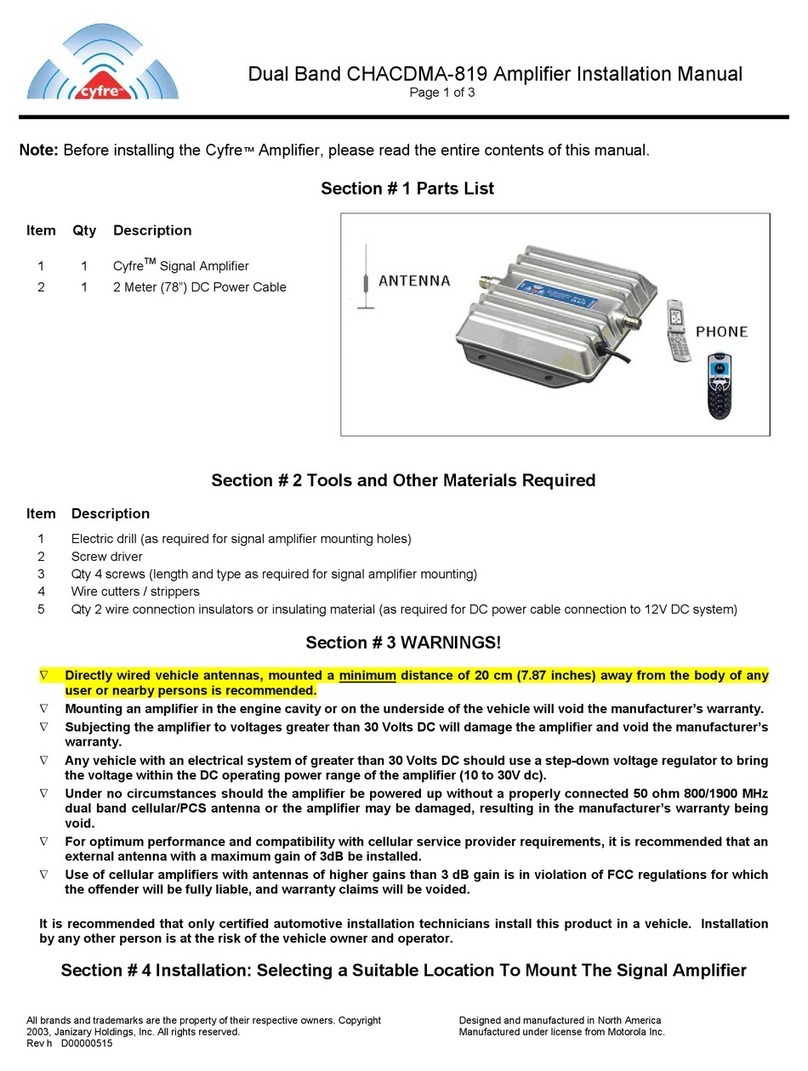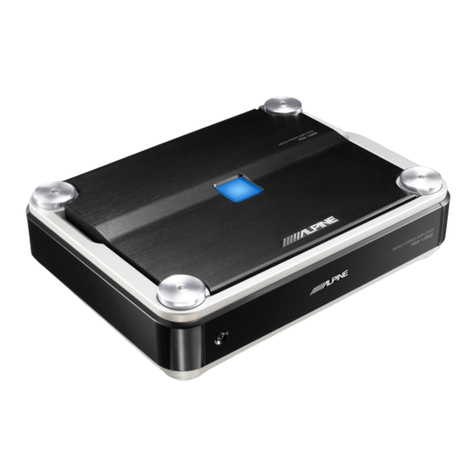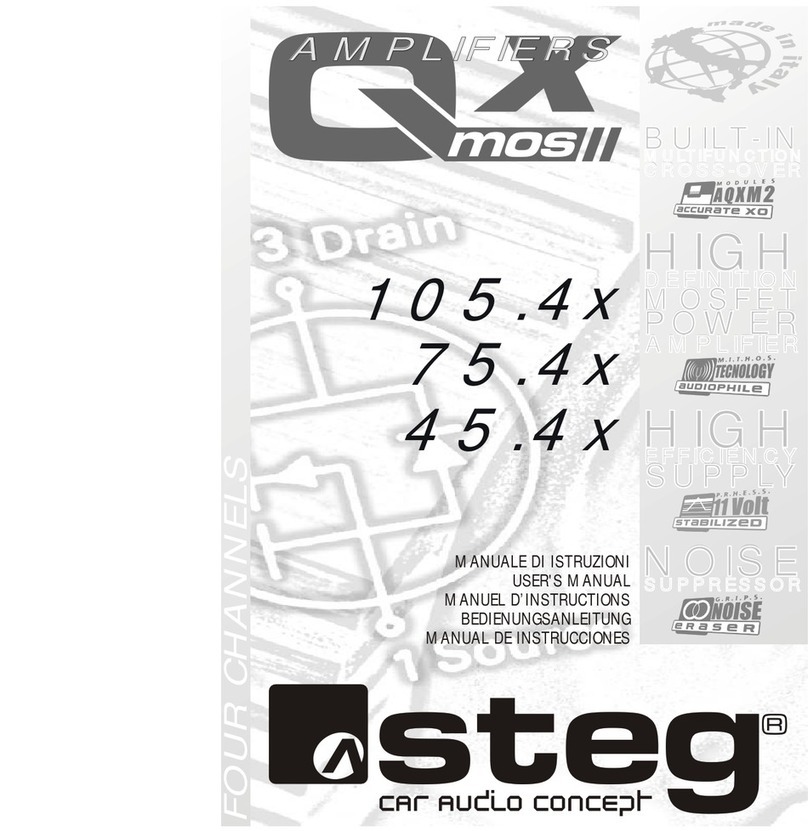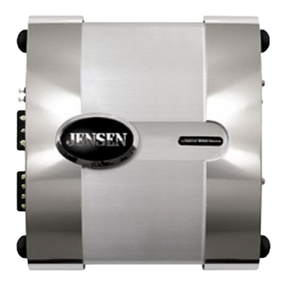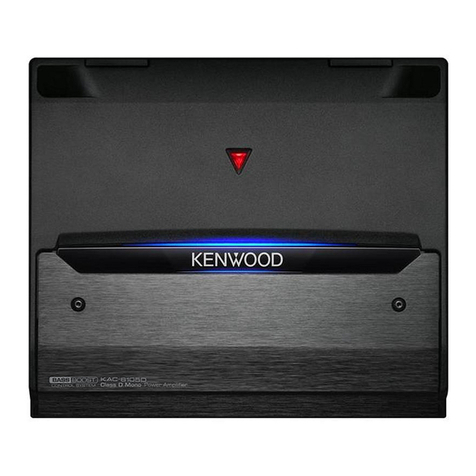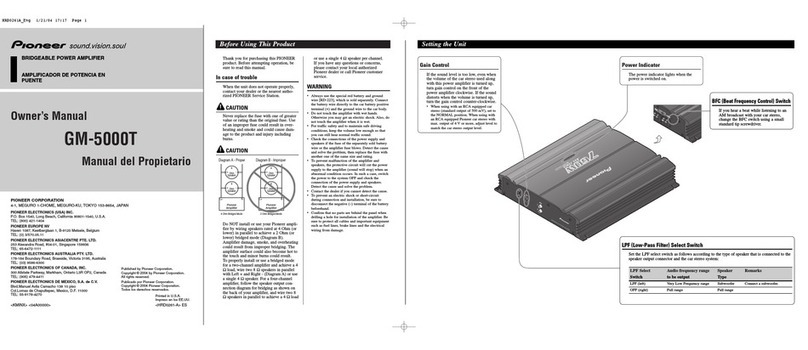To stabilize the operating voltage for the power
amplifier and thus the resulting power increase and
sound improvement, a power capacitor is recom-
mended (e. g. CAP-...*).
6.1.3 Control voltage for switching-on
The car HiFi power amplifier is switched on and off by
a control voltage of +12 V at the terminal REM (11).
Connect the terminal REM to the 12 V control output
of the car radio (connection for a motor antenna, if
necessary, to be connected in parallel to the motor
antenna). The black connection strip can be removed
from the power amplifier for better handling when
fastening the connection cables with screws.
6.2 Inputs
The signal inputs (13, 14) of the power amplifier are
connected via cables with phono connectors to the
line outputs at the car radio (or another signal source).
However, if the car radio is not equipped with
line outputs, the speaker outputs of the car radio
can be connected via an audio transformer (e. g.
FGA-22HQ*) to the inputs of the power amplifier.
The connection of the inputs depends on the
desired operating mode of the power amplifier:
6.2.1 4-channel operation (fig. 2)
The 4-channel operation is required when using four
full range speakers (2-way or 3-way speakers). Con-
nect the outputs of the car radio to the inputs of the
power amplifier as follows:
front left to the jack FRONT L
front right to the jack FRONT R
rear left to the jack REAR L
rear right to the jack REAR R
If the car radio is not equipped with outputs for the
rear channels, connect the output of the car radio of
the left channel via a Y cable (e. g. CBA-25/SW*) to
the two inputs FRONT L and REAR L of the power
amplifier and the output of the right channel via a
second Y cable to the two inputs FRONT R and
REAR L (as shown in fig. 3).
6.2.2 Active 2-way operation (fig. 3)
For active 2-way operation with mid-high range
speakers and bass speakers, each speaker is driven
by an individual amplifier channel. The frequency
ranges between the mid-high speakers and the
bass speakers are limited by the integrated cross-
over networks (chapter 7.1). Connect the outputs
of the car radio to the following inputs of the power
amplifier:
Connect the output of the left channel via a Y cable
(e. g. CBA-25/SW*) to the two inputs FRONT L and
REAR L of the power amplifier and
the output of the right channel via a second Y cable
to the two inputs FRONT R and REAR R.
6.2.3 Bridge operation (fig. 4)
To increase the output power, the channels FRONT L
and FRONT R in bridge operation may drive the left
speaker and the channels REAR L and REAR R in
bridge operation the right speaker. Connect the out-
put of the car radio of the left channel via a Y cable
(e. g. CBA-25/SW*) to the two inputs FRONT L and
FRONT R of the power amplifier and the output of the
right channel via a second Y cable to the two inputs
REAR L and REAR R.
6.2.4 3-channel operation (fig. 5)
The 3-channel operation serves to support two full
range speakers by a subwoofer. To obtain a higher
power for the subwoofer, the channels REAR L and
REAR R are used in bridge circuit. Connect the out-
puts of the car radio to the inputs of the power ampli-
fier as follows:
left channel to channel FRONT L
right channel to channel FRONT R
subwoofer L to channel REAR L
subwoofer R to channel REAR R
If the car radio is not equipped with outputs for a sub-
woofer amplifier, connect the output of the left chan-
nel via a Y cable (e. g. CBA-25/SW*) to the two inputs
FRONT L and REAR L of the power amplifier and
the output of the right channel via a second Y cable
to the two inputs FRONT R and REAR R (see fig. 5).
6.3 Speakers
It is possible to use full range speakers (2-way or 3-
way speakers), mid-high range speakers, bass
speakers, or a subwoofer.
The highest output power is reached when connect-
ing 2 Ω speakers or a speaker group with a total
impedance of 2 Ω per channel (e. g. two 4 Ω speak-
ers connected in parallel). However, it is also possi-
Important!
All speakers must be connected with 2 poles, i. e.
without common ground connection.
When choosing suitable speakers, pay in any case
attention to their mechanical and electrical capabil-
ity in connection with the power used of the power
amplifier (specifications, page 9)
D
A
CH
6
GB
Zur Stabilisierung der Betriebsspannung für die
Endstufe und der damit verbundenen Leistungsstei-
gerung sowie Klangverbesserung wird ein Power-
Kondensator empfohlen (z. B. CAP-…*).
6.1.3 Steuerspannung zum Einschalten
Die Car-HiFi-Endstufe wird durch eine Steuerspan-
nung von +12 V am Anschluss REM (11) ein- und
ausgeschaltet. Den Anschluss REM mit dem 12-V-
Schaltausgang vom Autoradio verbinden (Anschluss
für eine Motorantenne, eventuell mit der Motoran-
tenne parallel schalten). Die schwarze Anschluss-
leiste lässt sich zu besseren Handhabung beim
Festschrauben der Anschlussleitungen von der
Endstufe abziehen.
6.2 Eingänge
Die Signaleingänge (13, 14) der Endstufe werden
über Cinch-Kabel mit den Line-Ausgängen am Auto-
radio (oder einer anderen Signalquelle) verbunden.
Sind am Autoradio jedoch keine Line-Ausgänge
vorhanden, können die Lautsprecherausgänge des
Autoradios über einen Audio-Übertrager (z. B. FGA-
22HQ*) mit den Eingängen der Endstufe verbunden
werden.
Der Anschluss der Eingänge richtet sich nach der
gewünschten Betriebsart der Endstufe:
6.2.1 4-Kanalbetrieb (Abb. 2)
Der 4-Kanalbetrieb wird beim Einsatz von vier Full-
Range-Lautsprechern (2- oder 3-Wege-Lautspre-
cher) benötigt. Die Ausgänge des Autoradios wie
folgt mit den Eingängen der Endstufe verbinden:
Front links mit der Buchse FRONT L
Front rechts mit der Buchse FRONT R
Rear links mit der Buchse REAR L
Rear rechts mit der Buchse REAR R
Sind am Autoradio keine Ausgänge für die hinteren
Kanäle (Rear) vorhanden, den Autoradio-Ausgang
des linken Kanals über ein Y-Kabel (z. B. CBA-
25/SW*) mit den beiden Endstufen-Eingängen
FRONT L und REAR L verbinden und den Ausgang
des rechten Kanals über ein zweites Y-Kabel mit
den beiden Eingängen FRONT R und REAR R (wie
in Abb. 3 dargestellt).
6.2.2 Aktiver 2-Wegebetrieb (Abb. 3)
Beim aktiven 2-Wegebetrieb mit Mittelhochtönern
und Basslautsprechern wird jeder Lautsprecher von
einem eigenen Verstärkerkanal angetrieben. Die
Frequenzaufteilung zwischen den Mittelhochtönern
und Basslautsprechern erfolgt durch die integrierten
Frequenzweichen (Kap. 7.1). Die Ausgänge des
Autoradios mit den folgenden Eingängen der End-
stufe verbinden:
Den Ausgang des linken Kanals über ein Y-Kabel
(z. B. CBA-25/SW*) mit den beiden Endstufen-Ein-
gängen FRONT L und REAR L verbinden und
den Ausgang des rechten Kanals über ein zweites
Y-Kabel mit den beiden Eingängen FRONT R und
REAR R.
6.2.3 Brückenbetrieb (Abb. 4)
Zur Erhöhung der Ausgangsleistung können die
Kanäle FRONT L und FRONT R in Brückenschal-
tung den linken Lautsprecher antreiben sowie die
Kanäle REAR L und REAR R in Brückenschaltung
den rechten Lautsprecher. Dazu den Autoradio-Aus-
gang des linken Kanals über ein Y-Kabel (z. B. CBA-
25/SW*) mit den beiden Endstufen-Eingängen
FRONT L und FRONT R verbinden und den Aus-
gang des rechten Kanals über ein zweites Y-Kabel
mit den beiden Eingängen REAR L und REAR R.
6.2.4 3-Kanalbetrieb (Abb. 5)
Der 3-Kanalbetrieb dient zur Unterstützung von zwei
Full-Range-Lautsprechern durch einen Subwoofer.
Um für den Subwoofer eine höhere Leistung zu
erhalten, werden die Kanäle REAR L und REAR R in
Brücke geschaltet. Die Ausgänge des Autoradios
wie folgt mit den Eingängen der Endstufe verbinden:
linker Kanal auf Kanal FRONT L
rechter Kanal auf Kanal FRONT R
Subwoofer L auf Kanal REAR L
Subwoofer R auf Kanal REAR R
Sind am Autoradio keine Ausgänge für einen Sub-
woofer-Verstärker vorhanden, den Ausgang des lin-
ken Kanals über ein Y-Kabel (z. B. CBA-25/SW*) mit
den beiden Endstufen-Eingängen FRONT L und
REAR L verbinden und
den Ausgang des rechten Kanals über ein zweites
Y-Kabel mit den beiden Eingängen FRONT R und
REAR R (siehe Abb. 5).
6.3 Lautsprecher
Es lassen sich Full-Range-Lautsprecher (2- oder 3-
Wege-Lautsprecher), Mittelhochtöner, Basslaut-
sprecher oder ein Subwoofer betreiben.
Die größte Ausgangsleistung wird beim Anschluss
von 2-Ω-Lautsprechern oder einer Lautsprecher-
gruppe mit einer Gesamtimpedanz von 2 Ω pro
Wichtig!
Alle Lautsprecher müssen 2-polig angeschlossen
werden, d. h. ohne gemeinsamen Masseanschluss.
Bei der Auswahl geeigneter Lautsprecher unbe-
dingt deren mechanische und elektrische Belast-
barkeit im Zusammenhang mit der genutzten End-
stufenleistung berücksichtigen (Technische
Daten, Seite 9).
*von CARPOWER
*by CARPOWER
